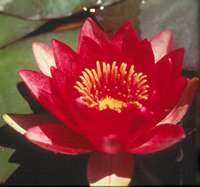Search
For The Answer
Click here to access our database of
Plant Answers
Search
For The Picture
Click here to access the Google database of plants
and insects
Information Index
Alphabetical Listing of Topics, Recommendations
and Plants
Milberger's Nursery and Landscaping
3920 North Loop 1604 E.
San Antonio, TX 78247
210.497.3760
nursery@milbergersa.com
Open 9 to 6 Mon. through Sat.
and 10 to 5 on Sun.

Three exits east of 281, inside of 1604
Next to the Diamond Shamrock station
Please click map for more detailed map and driving directions.



Hardy
Water Lillies– Tropical Day Bloomers
–Tropical Night Bloomers
Lotus – Bog Plants –Victoria
Lily
Dr. Clyde Ikins Lakeside Gardens – Garden
Scenes –
Informational Articles
Koi
|
Water gardens thus had their beginnings in
the fabric of both human history and the processes of Mother Nature.
Water plants create conditions suitable for pests and diseases
affecting humans, domestic animals, and crop plants. Some water
plants were even singled out as having religious significance.
In the Orient, particularly in China from around 2700 B.C., nelumbos
especially had religious connotations and were esteemed for their
medicinal properties. Later, nelumbos spread to Egypt. |

 Water
is an essential element, without which life cannot be long sustained.
Civilization's first settlements sprang up around rivers due to
irrigation and transportation needs. Soon various aquatic and
bog plants were recognized as a source of food and shelter. Certain
aquatic plants also provided food, such as rich, which is the
most important crop species in the world.
Water
is an essential element, without which life cannot be long sustained.
Civilization's first settlements sprang up around rivers due to
irrigation and transportation needs. Soon various aquatic and
bog plants were recognized as a source of food and shelter. Certain
aquatic plants also provided food, such as rich, which is the
most important crop species in the world.  Widespread
though reverence for the lotus has been, most of our knowledge
concerning the early uses of water plants has come from ancient
Egypt, where nymphaeas, nelumbos, and papyruses in particular
are widely represented on tomb wall paintings, found as dried
blossoms in sarcophagi, and reproduced as decorative elements
on pillars and columns in architecture. The use of flowers for
social purposes was tremendously important to the ancient Egyptians.
Following the anointing ceremony at a nobleman's reception, servants
presented each guest with a lotus flower that was then either
held in the hand or attached to the head before visitors entered
the reception rooms. At some period in their history, Indian poets
have likened many parts of the human body to the Nelumbo. To the
Chinese it typified female beauty, while the Japanese considered
the plant an emblem of purity since the splendid flowers grew
unsullied by the muddy waters of its habitat.
Widespread
though reverence for the lotus has been, most of our knowledge
concerning the early uses of water plants has come from ancient
Egypt, where nymphaeas, nelumbos, and papyruses in particular
are widely represented on tomb wall paintings, found as dried
blossoms in sarcophagi, and reproduced as decorative elements
on pillars and columns in architecture. The use of flowers for
social purposes was tremendously important to the ancient Egyptians.
Following the anointing ceremony at a nobleman's reception, servants
presented each guest with a lotus flower that was then either
held in the hand or attached to the head before visitors entered
the reception rooms. At some period in their history, Indian poets
have likened many parts of the human body to the Nelumbo. To the
Chinese it typified female beauty, while the Japanese considered
the plant an emblem of purity since the splendid flowers grew
unsullied by the muddy waters of its habitat.